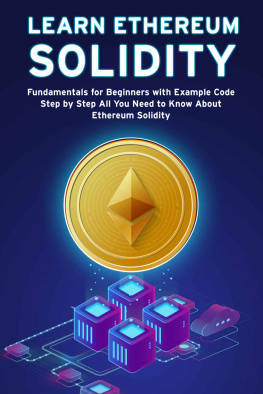Chris Dannen [Chris Dannen] - Introducing Ethereum and Solidity: Foundations of Cryptocurrency and Blockchain Programming for Beginners
Here you can read online Chris Dannen [Chris Dannen] - Introducing Ethereum and Solidity: Foundations of Cryptocurrency and Blockchain Programming for Beginners full text of the book (entire story) in english for free. Download pdf and epub, get meaning, cover and reviews about this ebook. year: 2017, publisher: Apress, genre: Computer. Description of the work, (preface) as well as reviews are available. Best literature library LitArk.com created for fans of good reading and offers a wide selection of genres:
Romance novel
Science fiction
Adventure
Detective
Science
History
Home and family
Prose
Art
Politics
Computer
Non-fiction
Religion
Business
Children
Humor
Choose a favorite category and find really read worthwhile books. Enjoy immersion in the world of imagination, feel the emotions of the characters or learn something new for yourself, make an fascinating discovery.
- Book:Introducing Ethereum and Solidity: Foundations of Cryptocurrency and Blockchain Programming for Beginners
- Author:
- Publisher:Apress
- Genre:
- Year:2017
- Rating:5 / 5
- Favourites:Add to favourites
- Your mark:
Introducing Ethereum and Solidity: Foundations of Cryptocurrency and Blockchain Programming for Beginners: summary, description and annotation
We offer to read an annotation, description, summary or preface (depends on what the author of the book "Introducing Ethereum and Solidity: Foundations of Cryptocurrency and Blockchain Programming for Beginners" wrote himself). If you haven't found the necessary information about the book — write in the comments, we will try to find it.
Learn how to use Solidity and the Ethereum project second only to Bitcoin in market capitalization. Blockchain protocols are taking the world by storm, and the Ethereum project, with its Turing-complete scripting language Solidity, has rapidly become a front-runner. This book presents the blockchain phenomenon in context; then situates Ethereum in a world pioneered by Bitcoin.
See why professionals and non-professionals alike are honing their skills in smart contract patterns and distributed application development. Youll review the fundamentals of programming and networking, alongside its introduction to the new discipline of crypto-economics. Youll then deploy smart contracts of your own, and learn how they can serve as a back-end for JavaScript and HTML applications on the Web.
Many Solidity tutorials out there today have the same flaw: they are written for advanced JavaScript developers who want to transfer their skills to a blockchain environment. Introducing Ethereum and Solidity is accessible to technology professionals and enthusiasts of all levels. Youll find exciting sample code that can move forward real world assets in both the academic and the corporate arenas. Find out now why this book is a powerful gateway for creative technologists of all types, from concept to deployment.
What Youll Learn
See how Ethereum (and other cryptocurrencies) work
Compare distributed apps (dapps) to web apps
Write Ethereum smart contracts in Solidity
Connect Ethereum smart contracts to your HTML/CSS/JavaScript web applications
Deploy your own dapp, coin, and blockchain
Work with basic and intermediate smart contracts
Who This Book Is For
Anyone who is curious about Ethereum or has some familiarity with computer science Product managers, CTOs, and experienced JavaScript programmers
Experts will find the advanced sample projects in this book rewarding because of the power of Solidity
Chris Dannen [Chris Dannen]: author's other books
Who wrote Introducing Ethereum and Solidity: Foundations of Cryptocurrency and Blockchain Programming for Beginners? Find out the surname, the name of the author of the book and a list of all author's works by series.

![Chris Dannen [Chris Dannen] Introducing Ethereum and Solidity: Foundations of Cryptocurrency and Blockchain Programming for Beginners](/uploads/posts/book/119690/thumbs/chris-dannen-chris-dannen-introducing-ethereum.jpg)







![Fatima Castiglione Maldonado [Fatima Castiglione Maldonado] - Introduction to Blockchain and Ethereum](/uploads/posts/book/119687/thumbs/fatima-castiglione-maldonado-fatima-castiglione.jpg)